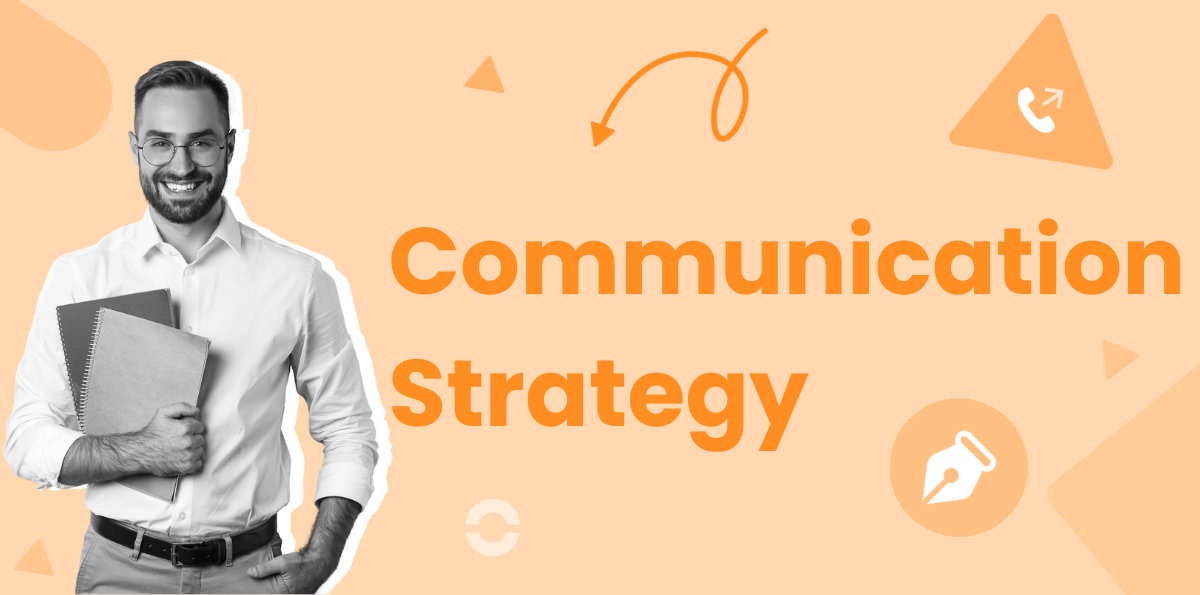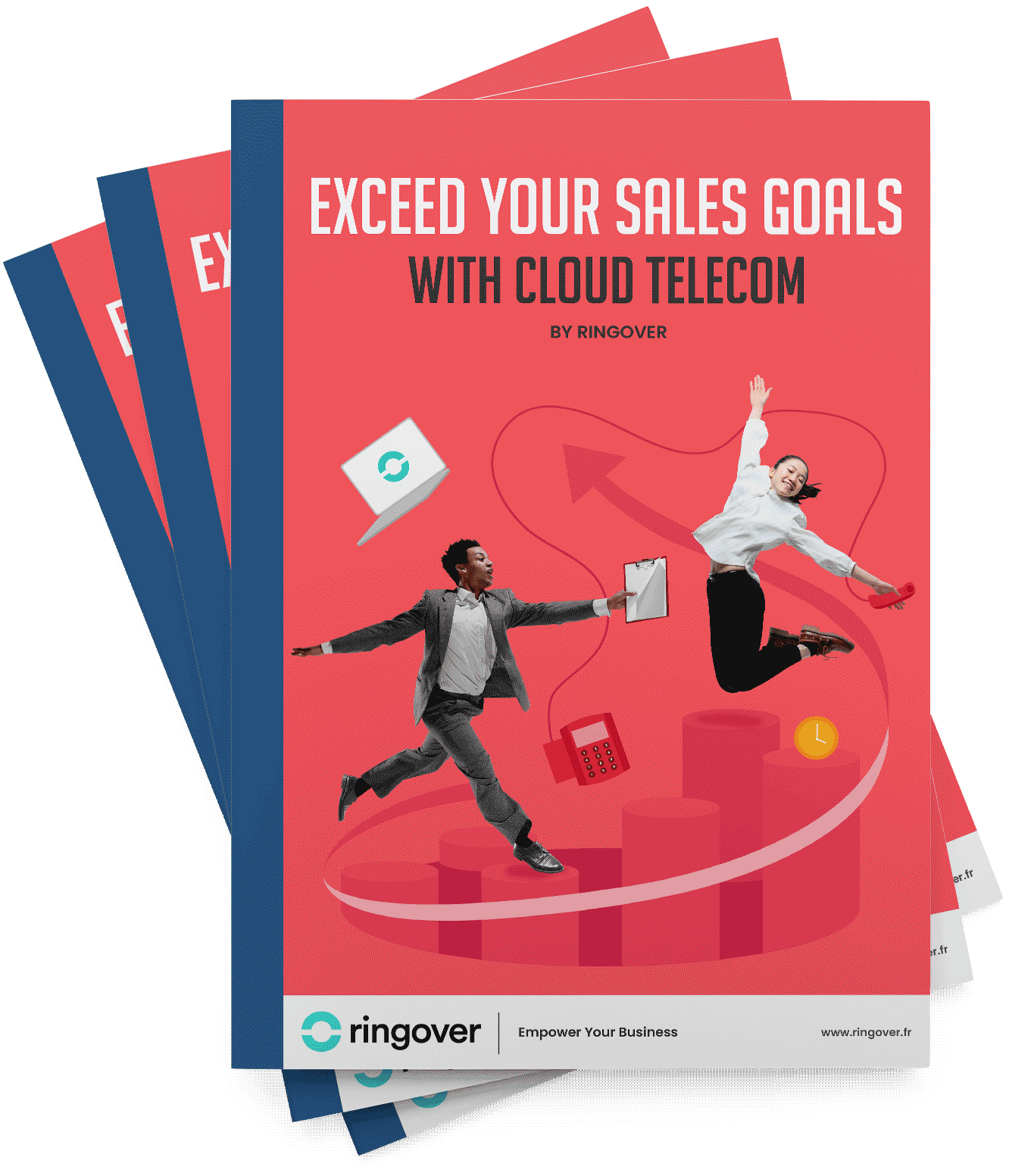Summary
Incorporating a communication strategy will help you navigate the following questions. Which channels are most relevant for your audience and message? What are the best practices for successful communication? This article guides you through the key steps to develop a customized and effective communication strategy that perfectly meets your requirements.
Boost Your Communication Strategy With RingoverCommunication Strategy Definition
A communication strategy is an action plan designed to choose and execute the necessary steps to meet established communication objectives. It is developed within the framework of an overall marketing reflection and takes into account the company's identity, its positioning, and its target audience.
This strategy includes several essential components, such as the communication axis, which determines the main message to be conveyed and the tone to be used; the communication plan, which specifies the actions to be taken, the channels to be used, the necessary resources, and the allocated budget; as well as the dashboard, an indispensable tool for measuring and evaluating the effectiveness of communication efforts.
An effective communication strategy must be coherent and adapted to the different targeted audiences, in addition to being specific to the desired goals. It must also be flexible and capable of adapting to market fluctuations and consumer feedback.
How to Develop a Communication Strategy?
Developing a communication strategy requires a well-defined method, adapted to your context, market, and target audience. Here is a 7-step guide to accompany you:
- Analyze your market and your positioning relative to the competition
- Identify and understand your target, including its needs, expectations, and behaviors
- Define your brand identity, your message, and your communication style
- Determine your communication objectives, whether based on quantitative or qualitative criteria
- Select your communication channels, based on your budget, target audience, and message
- Execute precise communication actions, respecting the schedule and allocated resources
- Evaluate the results of your communication strategy using relevant performance indicators
We provide concrete examples for each step, especially for B2B companies with unique communication challenges.
Track the effectiveness of your communication strategy with Ringover’s reporting dashboard.
1. Analyze your market and competitive positioning
Start with an in-depth analysis of your market and your positioning relative to your competitors. This includes identifying strengths, weaknesses, opportunities, and threats, as well as the characteristics and trends of your sector.
The SWOT or PESTEL matrices are excellent tools for this analysis. This will allow you to highlight your competitive advantage, that is, what distinguishes you and makes you unique in the eyes of your clients, such as your added value or innovation.
For example, a B2B company in industrial machine manufacturing can position itself as a leader by differentiating itself through custom solutions and quality after-sales service.
2. Identify and understand your target
This step aims to determine and deeply understand your target audience through their motivations, needs, expectations, concerns, and consumption habits.
Using personas or customer journey maps can help you create typical profiles of your ideal clients.
This guides you in adapting your communication to best meet the expectations of your target, by choosing the appropriate tone, message, and channel. It is also wise to segment your target according to various relevant criteria.
3. Establish your brand identity, message, and communication style
Clearly define your company's personality, the values you uphold, the message to be conveyed, and the communication tone. Creating an editorial or graphic charter formalizes these elements.
This approach strengthens your brand image, ensuring consistency and recognition among your target audience. You could also develop a slogan, a logo, or any other significant identity element.
4. Define your communication objectives
Set clear and measurable communication objectives, aligned with your overall marketing strategy. The SMART method will help you formulate specific, measurable, achievable, realistic, and time-bound objectives.
This phase is crucial for guiding and assessing the effectiveness of your communication.

5. Choose your communication channels
Choose the most appropriate communication channels based on your budget, target audience, and the message to be conveyed. A study of the various available supports and their effectiveness at each stage of the customer journey will help in this selection.
This approach maximizes the impact of your communication while controlling costs.
6. Execute concrete communication actions
It is time to act by implementing the planned content, supports, and communication tools at strategic moments and locations.
The use of planning tools like the editorial calendar is recommended to efficiently organize these actions.
7. Evaluate the results of your communication
Finally, measure the effectiveness of your communication by analyzing key performance indicators. This will allow you to verify the achievement of your objectives and adjust your strategy if necessary.
Your return on investment and the feedback collected provide valuable insights to improve your future communication actions.
For easy application of your communication strategy, here is a summary table of the main steps and their key elements.
| Steps | Key Elements | Examples |
|---|---|---|
| Market analysis and positioning | Competitive advantage | Expertise, custom solutions, after-sales service |
| Identification of your target | Persona | SME director, seeking process simplification, interest in free demos |
| Establishment of your brand identity | Slogan | Partner in professional success, offering quality training to all |
| Communication objectives | SMART objectives | Generate 100 qualified leads in 3 months |
| Choice of communication channels | Communication mix | Website, social media, newsletter, blog, press, partners, etc. |
| Concrete communication actions | Editorial calendar | Personalized emails, sent at key moments, tracking open and conversion rates |
| Evaluation of results | Dashboard | Volume of visitors, contacts, prospects, and clients obtained, costs, customer satisfaction |
Which channels should be prioritized?
Choosing the right communication channels is crucial to effectively disseminate your message to your target audience.
There are a multitude of channels available, but finding the ones that best match your strategy, budget, and audience is key. It is essential to select the most relevant channels to achieve your objectives.
Start by asking yourself who your target audience is, what your message is, what your objectives are, and what your budget is. Then, determine which channels are preferred and most effective for your audience.
By answering these questions, you can identify the most suitable channels for your communication strategy.
Here is an overview of various communication channels, their cost, and how they can be used effectively:
The Website
Essential for presenting your company and its offerings, generating traffic, and leads.
- Cost: Depends on the complexity of the site (from a few hundred to several thousand euros for initial design and development, with recurring costs for hosting and maintenance).
- Use: Ensure it is responsive, ergonomic, secure, and easy to update.
Social Media
Ideal for building a community, sharing relevant content, and interacting with your audience.
- Cost: Creating accounts is generally free, but paid advertisements can range from a few euros per day to several thousand euros per month, depending on the desired reach.
- Use: The key is to post regularly and actively engage with your followers.
Blogs and Influencers
Perfect for establishing credibility, creating valuable content, and reaching a new audience through partnerships.
- Cost: Managing a blog can be inexpensive, but collaborating with influencers can vary greatly (from a few hundred to several thousand euros per post, depending on the influencer's notoriety).
- Use: The relevance and originality of the content are paramount.
Emailing and SMS
Effective for directly communicating with your target, personalizing your approach, and promoting your offers while respecting GDPR rules.
- Cost: Emailing services can cost between 20 and 500 euros per month, depending on the number of emails sent and the features offered. SMS campaigns are generally billed per unit, with an average cost of 0.05 to 0.15 euros per SMS.
- Use: Precisely target your messages to maximize engagement and conversion rates.
Events
Allows you to strengthen the bond with your audience, whether through physical or virtual events.
- Cost: Very variable, depending on the size and type of event. A small event can cost a few hundred euros, while a large trade show or conference can cost several tens of thousands of euros.
- Use: Organization and promotion are crucial for its success.
Phone Calls
For B2B companies, unlimited calls are a crucial channel. It promotes direct communication, trust-building, and effective business activity management.
To make the most of it, it is important to have an appropriate phone solution like Ringover, which offers flexibility, integration with your existing tools, and advanced features for optimized communication management thanks to its omnichannel contact center software.
Ringover simplifies the management of your business phone system, with the ability to create call campaigns, synchronize with your CRM tools, use AI tools like Empower by Ringover to transcribe your calls, and much more, while providing detailed analytics to improve communication performance.
Optimizing your phone communication with Ringover can significantly boost your business. To discover all the features, try Ringover with no commitment.
Best Practices for Effective Communication
Effective communication achieves its objectives, is adapted to its context and audience, is understood and appreciated by all, and does not lead to misunderstandings or conflicts. Here are some key elements, applicable to both written and oral communication, to achieve this:
- Respect the 7Cs of Communication: Clarity, Conciseness, Concreteness, Correctness, Coherence, Completeness, and Courtesy. These principles are essential for effectively structuring your message, selecting appropriate vocabulary, communicating important information, and establishing a positive relationship with your audience.
- Adapt Your Message to Your Audience: It is crucial to know your audience well (their needs, expectations, preferences, level of knowledge, etc.) to personalize your communication, choose the appropriate channel, generate interest, and encourage engagement.
- Enrich Your Message: Using examples, figures, images, or metaphors, for example, enriches your discourse, enhances your credibility, captures attention, facilitates understanding, and makes your communication memorable.
- Engage in the Exchange: Communication is a true exchange, not a monologue. It is vital to listen actively, ask questions, rephrase, seek opinions, and consider feedback to ensure understanding, clarify ambiguities, demonstrate your interest, and stimulate dialogue.
- Show Assertiveness and Empathy: Assertiveness, the art of expressing ideas and needs in a way that is neither aggressive nor passive, and empathy, the ability to put oneself in another's place, are fundamental for respectful, sincere, constructive, and kind communication.
By applying these strategies, you will significantly improve the quality of your communication, thereby enhancing your professional effectiveness, brand image, and relationships with colleagues, clients, and partners.
Conclusion
You now have the essential tools to develop an effective communication strategy for your company. You understand the importance of a communication strategy, how to implement it, which channels to prioritize, and the best practices to follow.
This knowledge will allow you to improve your communication, strengthen your brand, achieve your goals, and grow your business.
Ringover can help you deploy your communication strategy, particularly in the telephony area (unlimited calls, text messages, voicemail drops). Ringover can also help you implement your omnichannel strategy through its dedicated add-on that supports WhatsApp, Google reviews, professional emails, text messages, and more.
Don't hesitate to discover Ringover by trying our service free and seize the opportunity to experience the benefits of cloud communication for your business.




